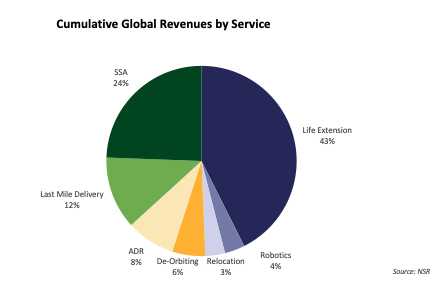Paving the Way Towards a Circular Space Economy
In response to the growing call for a safer space environment, Astroscale, Clearspace, and Starfish Space, among others, are positioning their practices as the essential ingredient for space sustainability. In-Orbit Service (IOS) advancements equally contribute to a safer space environment and unlock the potential of a circular space economy. ESA defines this as “ensuring long term orbital sustainability through IOS” and includes “On Orbit Manufacturing, Assembly and Recycling (OMAR)”. But to get there, the IOS market still faces significant challenges to overcome such as lack of funding, regulations, uncertainty about demand, and thus revenue streams. Amongst all these challenges, what is needed to get to a circular space economy?
State of the IOSM Market
NSR’s In-Orbit Services: Satellite Servicing, ADR & SSA, 6th Edition report forecasts the market to generate $14.3B cumulatively by 2032, with Life Extension (LE) driving 44% of total market revenues. The recent Mission Extension Pod orders with Northrop Grumman from GEO operators Intelsat and Optus demonstrate growing market confidence in Life Extension (LE) services in GEO. Following LE, Space Situational Awareness (SSA) presents the largest revenue opportunity in the IOS market with $3.5B, while Last Mile Delivery ($1.7B) is becoming more of a strategic market.

The “lower revenue markets” such as Relocation (3%), Robotics (4%), De-orbiting (6%) and Active Debris Removal (ADR) (8%) are not less important to sustainability but are currently less exposed to potential funding and revenue streams. Unlike on Earth, there are no penalties for creating debris in space nor are there incentives to promote an eco-friendly environment in space. As long as there are no obligations to make space sustainable and it remains with an option, the industry may seek solutions that sustain on the short term, such as LE and SSA.
Nonetheless, OMAR capabilities as ESA calls them, will be needed in the long term in a circular economy and underscore the significant growth potential in the IOS market. In fact, the space industry sees a missed opportunity in not repurposing or recycling the ISS, as the materials can be used for other commercial applications. But technology has not matured to the point where we are able to reuse or recycle materials in orbit.
Key Steps to a Circular Space Ecosystem
By 2050, ESA aims to establish a circular space economy, and NASA established an ISAM (In-Space Servicing, Assembly, and Manufacturing) consortium to bring industry together. The potential for ISAM capabilities is seen as enormous, as it promises to transform the economics of space exploration and utilization. By reducing the need for costly and complex ground-based manufacturing processes, ISAM capabilities such as recycling, re-purposing and re-using materials in space can significantly lower the costs of spacecraft production, launch, and maintenance, as is often touted for the ISS. And it will save the industry $B in waste while enabling the construction of advanced infrastructure for space stations, lunar habitats, and deep space exploration vehicles.
But 2050 is still a long wait for commercial players who have their ISAM business plan ready today, seeking for funding and partners who are equally delving in the unknown. This, in combination with lack of action on the part of the government, has led to initiatives where commercial industry takes over in setting the rules for sustainability. While this is pro-active, it would be beneficial for industry if governments speed up their implementation of regulations and provide incentives to develop standardized interfaces and protocols, promoting interoperability, and in turn, foster new collaborations, accelerate technology development, and drive costs down. This would also contribute to a clearer view of where the industry is headed and boost investor confidence.
The Bottom Line
A circular space economy and in particular, ISAM capabilities, can unlock new markets and revenue streams, including on-orbit satellite servicing, commercial space stations, and the construction of space-based resources. The development of a stable and sustainable space ecosystem hinges on several key factors, including standardization, industry collaboration, incentives, and supportive regulatory frameworks.
While there are government initiatives to enable the full spectrum of space sustainability, progress has been slow, pushing commercial industry to get together instead to capitalize on the immense potential of IOS technologies.
